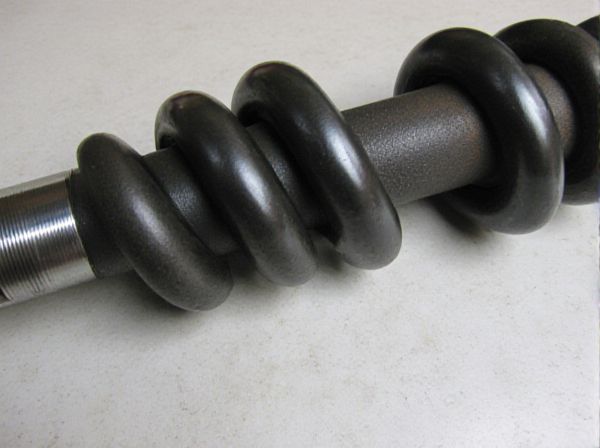
Photo illustration: High-angle Driveshaft vs Standard-angle Driveshaft
High-angle driveshafts are designed to accommodate extreme suspension articulation and larger pinion angles without compromising drivetrain performance, making them ideal for off-road and lifted vehicles. Standard-angle driveshafts work efficiently with moderate angles typically found in stock or mildly modified vehicles, providing smooth power transfer and reduced wear. Choosing the right driveshaft angle ensures your vehicle's drivetrain operates reliably and maximizes power delivery under varying driving conditions.
Table of Comparison
| Feature | High-angle Driveshaft | Standard-angle Driveshaft |
|---|---|---|
| Maximum Operating Angle | Up to 45 degrees | Typically up to 25 degrees |
| Application | Off-road vehicles, lifted trucks, and heavy-duty 4x4s | Standard vehicles, sedans, and light trucks |
| Durability | High durability under extreme angles and torque | Designed for moderate torque and angles |
| Vibration Levels | Reduced vibration at high operating angles | Minimal vibration at standard angles |
| Cost | Higher due to advanced engineering and materials | Lower, standard manufacturing process |
| Maintenance | Requires regular inspection for U-joints and balance | Standard maintenance intervals |
Introduction to Driveshaft Angles
Driveshaft angles significantly impact vehicle drivetrain performance, with high-angle driveshafts designed to accommodate greater angular displacement between transmission and differential components. Standard-angle driveshafts typically operate within a 3 to 5-degree range, optimizing vibration reduction and power transfer efficiency for most vehicles. High-angle driveshafts exceed 7 degrees, often found in lifted or off-road vehicles where suspension articulation demands increased driveline flexibility.
What Is a High-Angle Driveshaft?
A high-angle driveshaft is designed to operate efficiently at steeper angles, typically above 25 degrees, where standard-angle driveshafts may experience increased vibration and wear. It utilizes advanced joint designs, such as constant velocity (CV) or double Cardan joints, to maintain smooth power transfer between the transmission and differential. These driveshafts are essential in lifted trucks, off-road vehicles, and applications with altered suspension geometry requiring greater articulation.
Understanding Standard-Angle Driveshafts
Standard-angle driveshafts operate within typical angular ranges, usually below 10-15 degrees, ensuring smooth power transfer between the transmission and the differential. These driveshafts utilize universal joints designed for low angular velocity to minimize vibrations and ensure efficient torque transmission. Proper alignment in standard-angle driveshafts reduces wear and extends drivetrain component life, making them ideal for most conventional vehicle applications.
Key Differences Between High-Angle and Standard-Angle Driveshafts
High-angle driveshafts are designed to operate efficiently at steep angles, typically exceeding 25 degrees, making them ideal for vehicles with significant suspension articulation or lifted drivetrains. Standard-angle driveshafts perform best at angles below 15 degrees, ensuring smoother power transfer and less vibration in conventional setups. Key differences include the use of advanced CV joints in high-angle driveshafts to handle increased angular stress versus the simpler U-joints found in standard-angle driveshafts.
Applications for High-Angle Driveshafts
High-angle driveshafts are specifically designed to accommodate applications where the driveline requires operation at steep angles, often exceeding 25 degrees, making them ideal for off-road vehicles, agricultural machinery, and industrial equipment with complex suspension or articulation needs. These driveshafts feature robust universal joints and often incorporate constant velocity (CV) joints or double Cardan designs to maintain smooth power transfer and reduce vibration under high angular stresses. Their ability to handle extreme angular displacement enhances durability and performance in environments where standard-angle driveshafts would suffer from premature wear or operational inefficiency.
Performance Impacts: High vs. Standard Angles
High-angle driveshafts typically experience increased vibrations and accelerated wear due to greater operating angles, which can reduce overall drivetrain efficiency compared to standard-angle driveshafts. Standard-angle driveshafts maintain optimal alignment, promoting smoother power transfer and longevity by minimizing angular velocity fluctuations and joint stress. Performance impacts of high-angle driveshafts often include reduced torque capacity and potential drivetrain component fatigue, whereas standard-angle designs support consistent power delivery and improved mechanical reliability.
Durability and Maintenance Considerations
High-angle driveshafts experience increased stress due to steeper operating angles, which can accelerate wear on universal joints and demand more frequent maintenance compared to standard-angle driveshafts. Durability is enhanced in standard-angle driveshafts as they operate within optimal alignment ranges, reducing vibrations and component fatigue. Proper lubrication and regular inspections are crucial for high-angle driveshafts to prevent premature failure and maintain drivetrain integrity.
Compatibility with Lifted Vehicles
High-angle driveshafts are specifically designed to handle the increased angles created by lifted vehicles, ensuring smoother power delivery and reduced vibration compared to standard-angle driveshafts. Lifted vehicles often require upgraded driveshafts to maintain proper alignment and prevent premature wear on U-joints, making high-angle driveshafts more compatible with significant suspension lifts. Standard-angle driveshafts typically perform well in stock or mildly lifted setups but may fail or cause driveline vibrations in vehicles with substantial lift heights.
Choosing the Right Driveshaft for Your Needs
Selecting the right driveshaft depends on your vehicle's suspension design and intended use, with high-angle driveshafts offering greater flexibility for lifted or off-road vehicles by accommodating steeper driveline angles and reducing vibrations. Standard-angle driveshafts suit factory suspension setups where driveline angles remain moderate, providing optimal reliability and efficiency under typical driving conditions. Understanding your vehicle's articulation and torque requirements helps ensure the chosen driveshaft enhances drivetrain performance while minimizing wear.
Conclusion: High-Angle vs. Standard-Angle Driveshafts
High-angle driveshafts excel in applications requiring greater suspension articulation and tighter driveshaft angles, often found in off-road and performance vehicles, due to their robust design and specialized materials. Standard-angle driveshafts provide optimal efficiency and longevity in typical driving conditions with minimal driveline vibration, making them ideal for everyday use and less extreme angles. Choosing between high-angle and standard-angle driveshafts depends on the vehicle's intended use, operating angles, and demands for durability versus smooth power delivery.
 caratoz.com
caratoz.com